FORD F650/750 2023 Owner's Guide
Manufacturer: FORD, Model Year: 2023, Model line: F650/750, Model: FORD F650/750 2023Pages: 378, PDF Size: 5.65 MB
Page 31 of 378
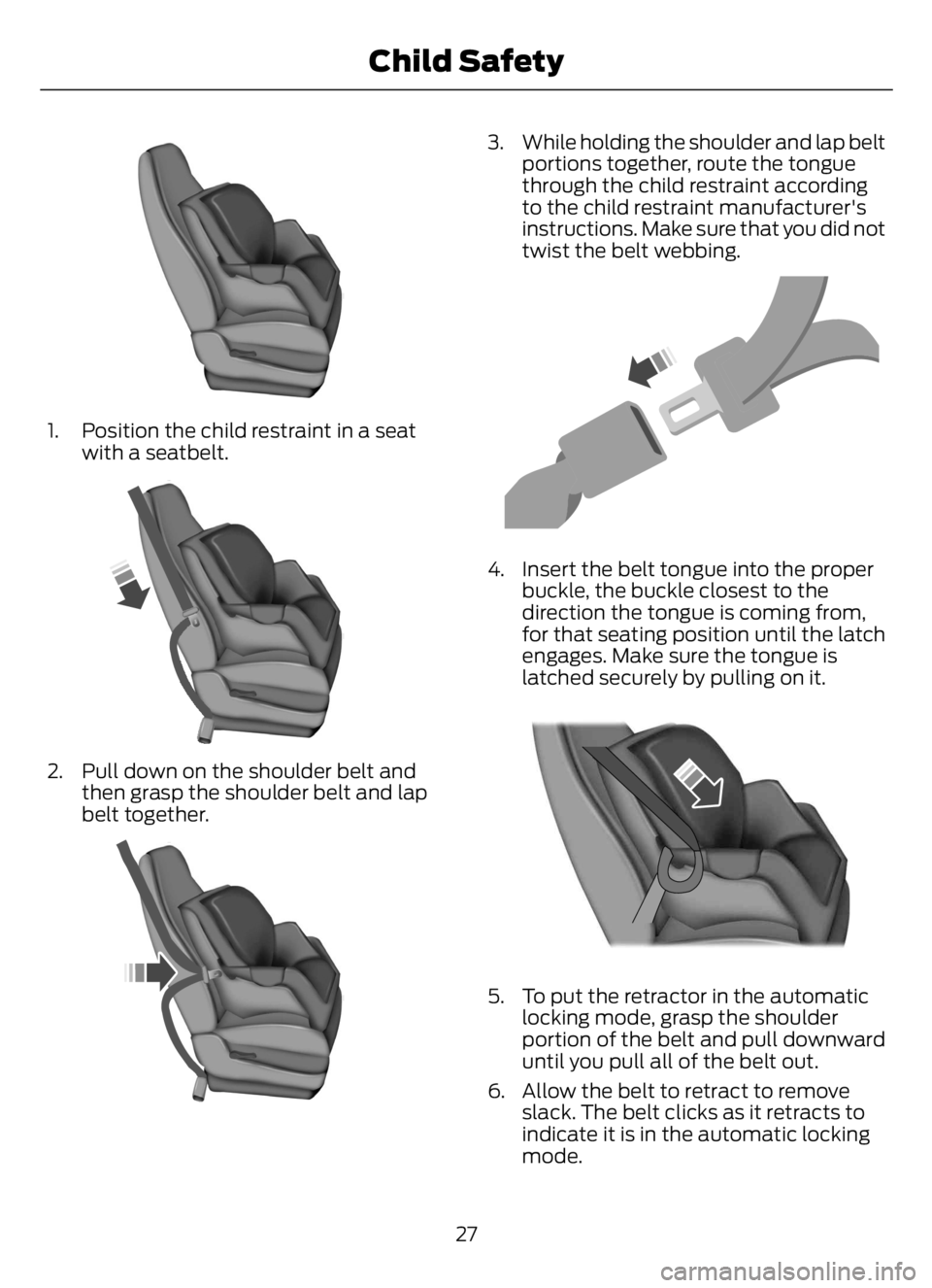
E142528
1. Position the child restraint in a seat
with a seatbelt.
E142529
2. Pull down on the shoulder belt and
then grasp the shoulder belt and lap
belt together.
E142530
3. While holding the shoulder and lap belt
portions together, route the tongue
through the child restraint according
to the child restraint manufacturer's
instructions. Make sure that you did not
twist the belt webbing.
4. Insert the belt tongue into the proper
buckle, the buckle closest to the
direction the tongue is coming from,
for that seating position until the latch
engages. Make sure the tongue is
latched securely by pulling on it.
E142875
5. To put the retractor in the automatic
locking mode, grasp the shoulder
portion of the belt and pull downward
until you pull all of the belt out.
6. Allow the belt to retract to remove
slack. The belt clicks as it retracts to
indicate it is in the automatic locking
mode.
27
Child Safety
Page 32 of 378
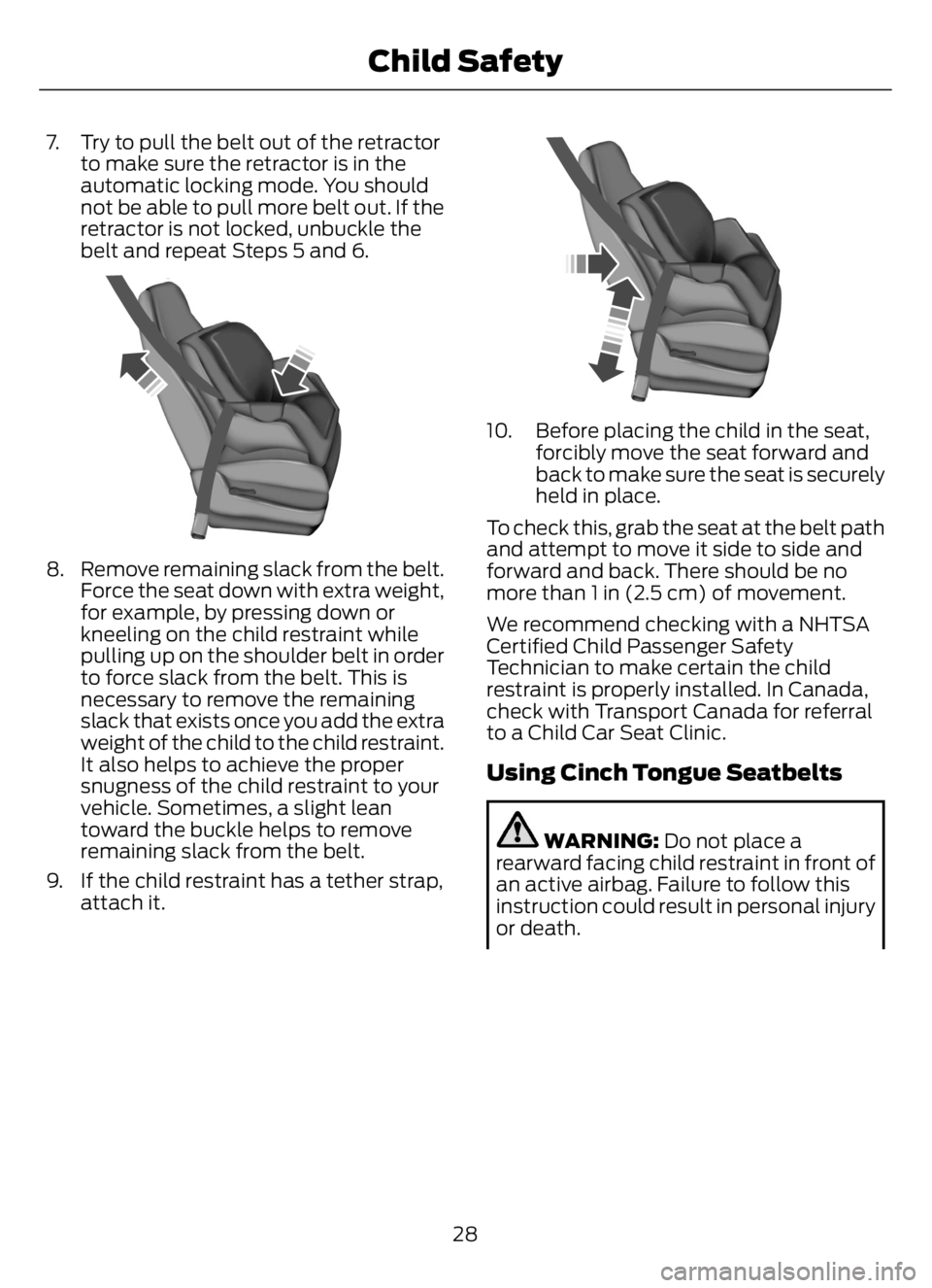
7. Try to pull the belt out of the retractor
to make sure the retractor is in the
automatic locking mode. You should
not be able to pull more belt out. If the
retractor is not locked, unbuckle the
belt and repeat Steps 5 and 6.
E142533
8. Remove remaining slack from the belt.
Force the seat down with extra weight,
for example, by pressing down or
kneeling on the child restraint while
pulling up on the shoulder belt in order
to force slack from the belt. This is
necessary to remove the remaining
slack that exists once you add the extra
weight of the child to the child restraint.
It also helps to achieve the proper
snugness of the child restraint to your
vehicle. Sometimes, a slight lean
toward the buckle helps to remove
remaining slack from the belt.
9. If the child restraint has a tether strap,
attach it.
E142534
10. Before placing the child in the seat,
forcibly move the seat forward and
back to make sure the seat is securely
held in place.
To check this, grab the seat at the belt path
and attempt to move it side to side and
forward and back. There should be no
more than 1 in (2.5 cm) of movement.
We recommend checking with a NHTSA
Certified Child Passenger Safety
Technician to make certain the child
restraint is properly installed. In Canada,
check with Transport Canada for referral
to a Child Car Seat Clinic.
Using Cinch Tongue Seatbelts
WARNING: Do not place a
rearward facing child restraint in front of
an active airbag. Failure to follow this
instruction could result in personal injury
or death.
28
Child Safety
Page 33 of 378
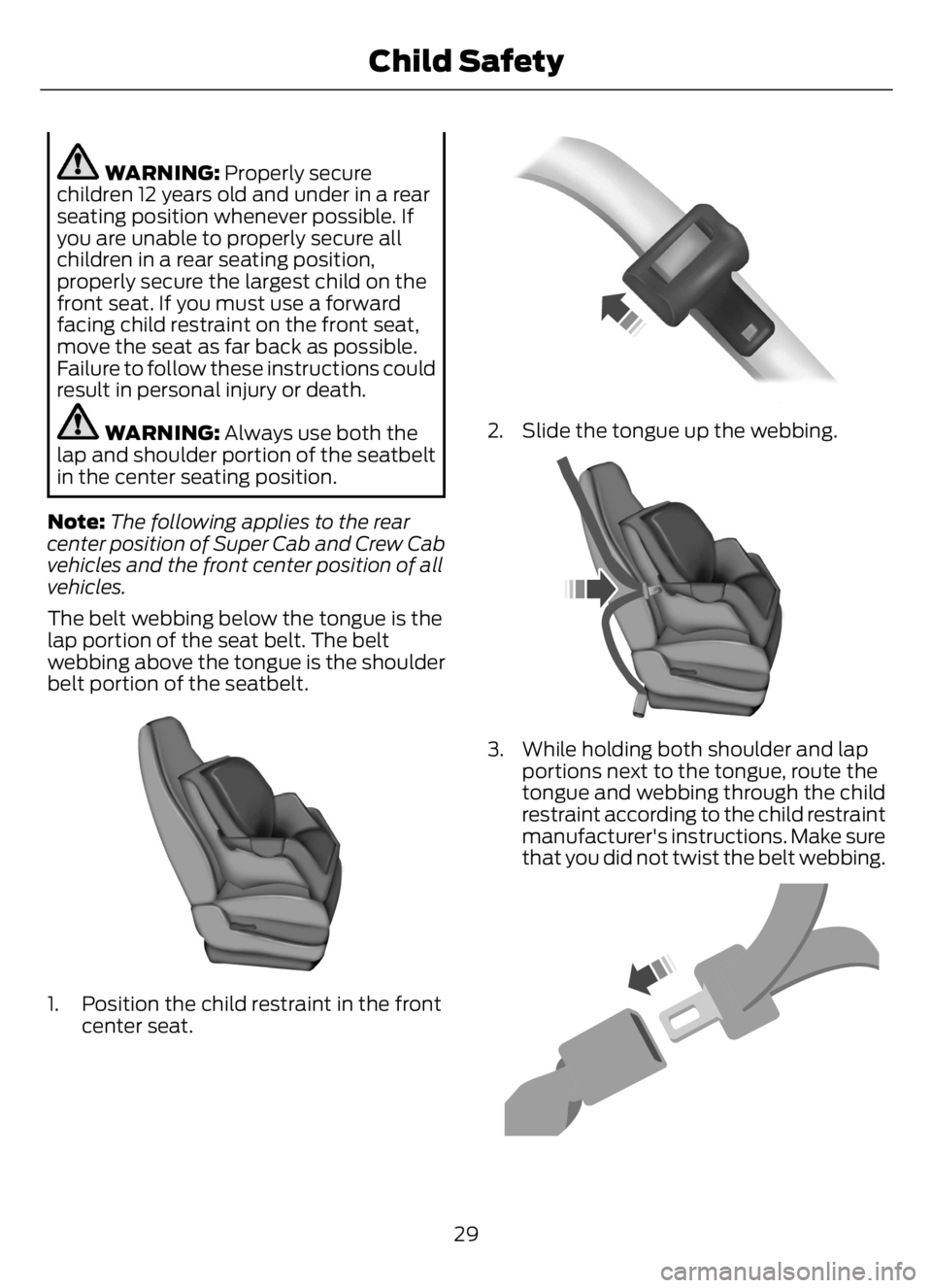
WARNING: Properly secure
children 12 years old and under in a rear
seating position whenever possible. If
you are unable to properly secure all
children in a rear seating position,
properly secure the largest child on the
front seat. If you must use a forward
facing child restraint on the front seat,
move the seat as far back as possible.
Failure to follow these instructions could
result in personal injury or death.
WARNING: Always use both the
lap and shoulder portion of the seatbelt
in the center seating position.
Note:The following applies to the rear
center position of Super Cab and Crew Cab
vehicles and the front center position of all
vehicles.
The belt webbing below the tongue is the
lap portion of the seat belt. The belt
webbing above the tongue is the shoulder
belt portion of the seatbelt.
E142528
1. Position the child restraint in the front
center seat.
E1162708E162708
2. Slide the tongue up the webbing.
E142530
3. While holding both shoulder and lap
portions next to the tongue, route the
tongue and webbing through the child
restraint according to the child restraint
manufacturer's instructions. Make sure
that you did not twist the belt webbing.
E142531
29
Child Safety
Page 34 of 378

4. Insert the belt tongue into the proper
buckle, the buckle closest to the
direction the tongue is coming from, or
that seating position until the latch
engages. Make sure the tongue is
latched securely by pulling on it.
E142533
5. While pushing down with your knee on
the child restraint, pull up on the
shoulder belt portion to tighten the lap
belt portion of the seat belt.
6. Allow the seatbelt to retract and
remove any slack in the belt to securely
tighten the child restraint in the vehicle.
7. If the child restraint has a tether strap,
attach it.
E142534
8. Before placing the child in the seat,
forcibly move the seat forward and
back to make sure the seat is securely
held in place. To check this, grab the
seat at the belt path and attempt to
move it side to side and forward and
back. There should be no more than
1 in (2.5 cm) of movement.
9. Check from time to time to be sure that
there is no slack in the seatbelt. The
shoulder belt must be snug to keep the
lap belt tight during a crash.
We recommend checking with a NHTSA
Certified Child Passenger Safety
Technician to make certain the child
restraint is properly installed. In Canada,
check with Transport Canada for referral
to a Child Car Seat Clinic.
Using Lower Anchors and Tethers
for Children
The Lower Anchors and Tethers for
CHildren (LATCH) system has three
vehicle anchor points:
• Two lower anchors where the vehicle
seat backrest and seat cushion meet,
called the seat bight.
• One top tether anchor behind that
seating position.
Your vehicle does not have the lower
anchor points in the seat bight. For this
vehicle, use the vehicle seatbelt and upper
tether to secure a child restraint.
Using Tether Straps
Many forward-facing child restraints
include a tether strap which extends from
the back of the child restraint and hooks
to an anchoring point called the top tether
anchor. Tether straps are available as an
accessory for many older child restraints.
30
Child Safety
Page 35 of 378
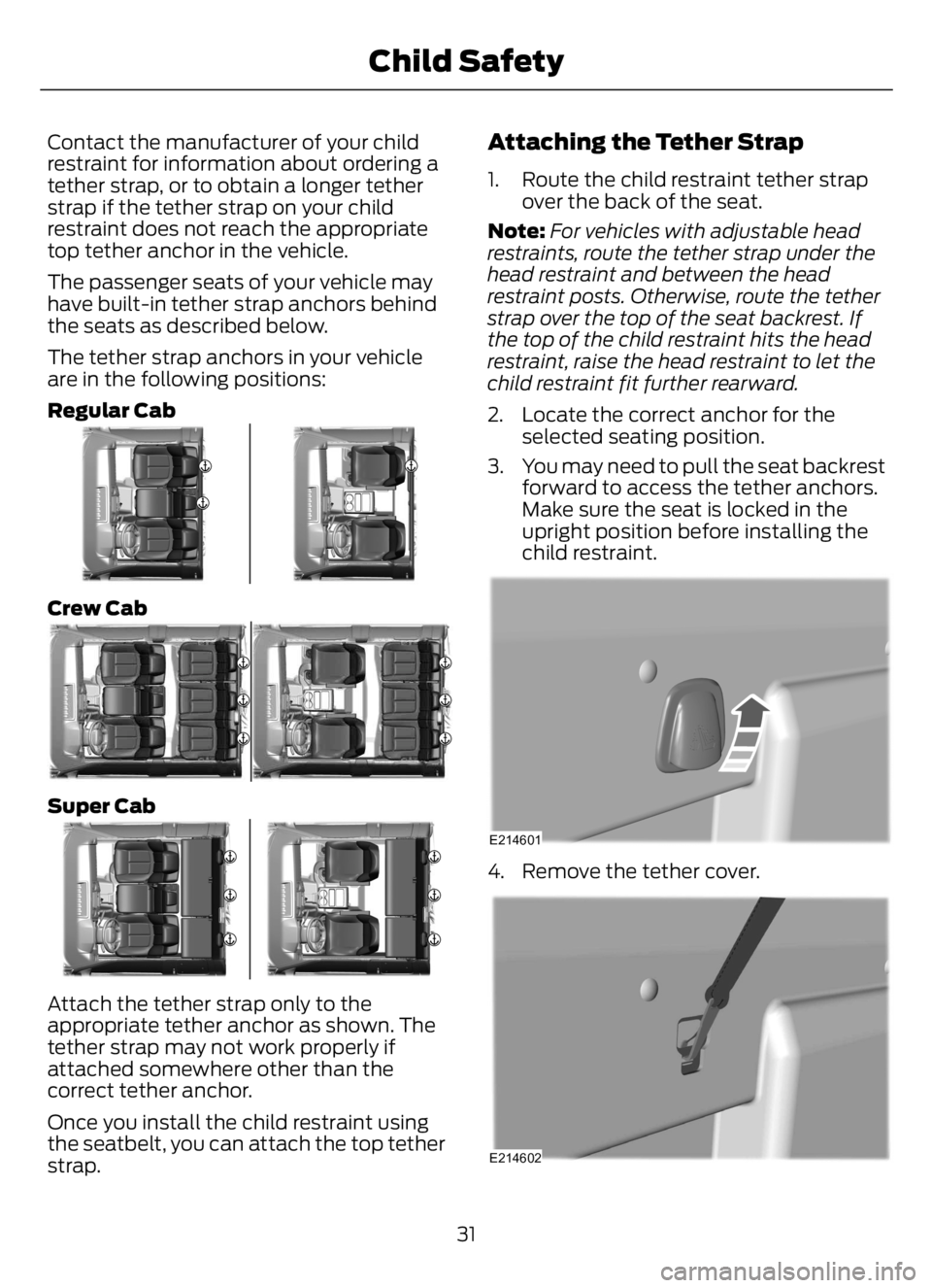
Contact the manufacturer of your child
restraint for information about ordering a
tether strap, or to obtain a longer tether
strap if the tether strap on your child
restraint does not reach the appropriate
top tether anchor in the vehicle.
The passenger seats of your vehicle may
have built-in tether strap anchors behind
the seats as described below.
The tether strap anchors in your vehicle
are in the following positions:
Regular Cab
E34591E3459111
Crew Cab
E345904E345904
Super Cab
E345910E345910591591091091991101010000059159191091159101910100599991110091091100591919159
Attach the tether strap only to the
appropriate tether anchor as shown. The
tether strap may not work properly if
attached somewhere other than the
correct tether anchor.
Once you install the child restraint using
the seatbelt, you can attach the top tether
strap.
Attaching the Tether Strap
1. Route the child restraint tether strap
over the back of the seat.
Note:For vehicles with adjustable head
restraints, route the tether strap under the
head restraint and between the head
restraint posts. Otherwise, route the tether
strap over the top of the seat backrest. If
the top of the child restraint hits the head
restraint, raise the head restraint to let the
child restraint fit further rearward.
2. Locate the correct anchor for the
selected seating position.
3. You may need to pull the seat backrest
forward to access the tether anchors.
Make sure the seat is locked in the
upright position before installing the
child restraint.
E214601
4. Remove the tether cover.
E214602
31
Child Safety
Page 36 of 378
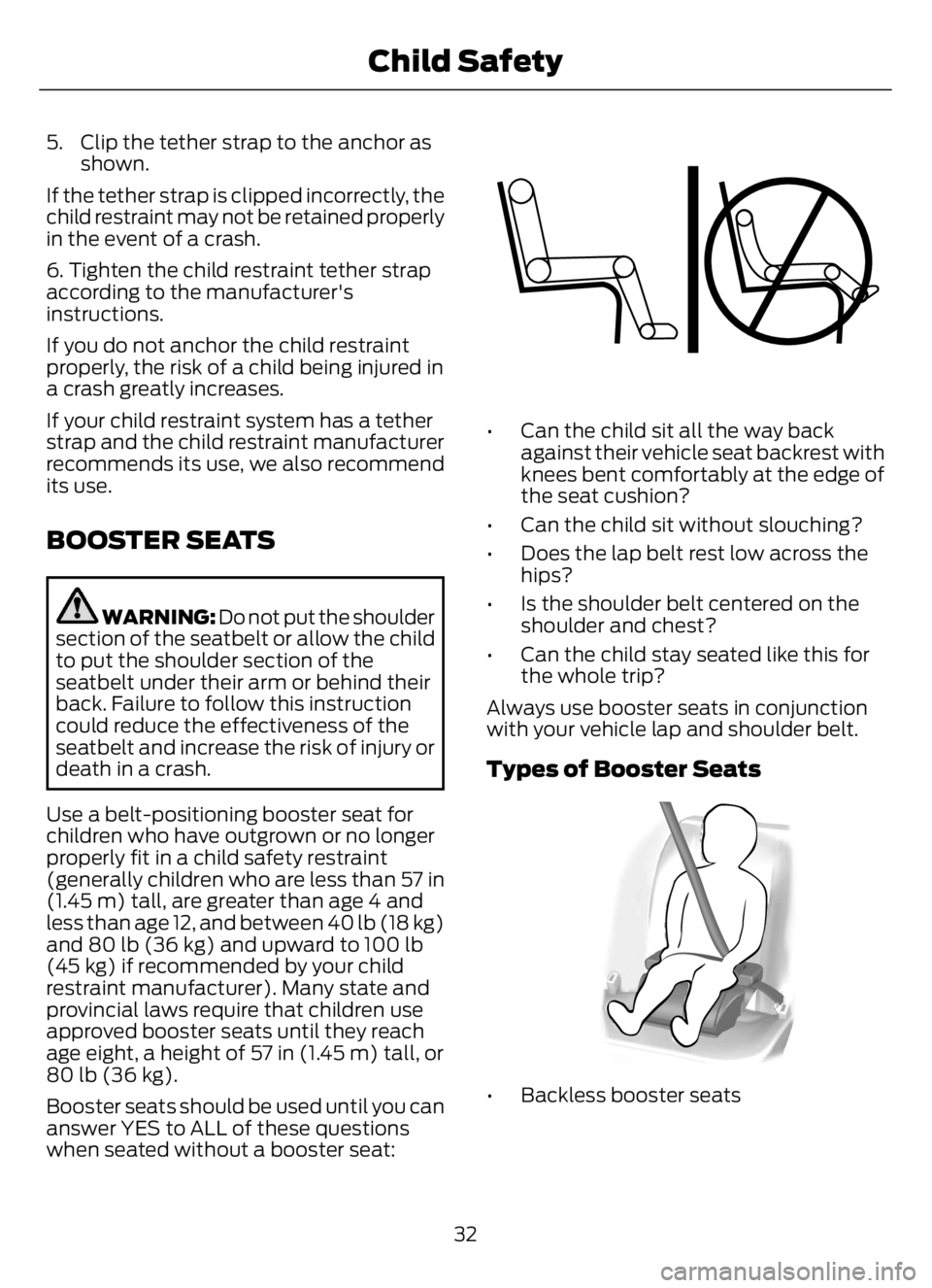
5. Clip the tether strap to the anchor as
shown.
If the tether strap is clipped incorrectly, the
child restraint may not be retained properly
in the event of a crash.
6. Tighten the child restraint tether strap
according to the manufacturer's
instructions.
If you do not anchor the child restraint
properly, the risk of a child being injured in
a crash greatly increases.
If your child restraint system has a tether
strap and the child restraint manufacturer
recommends its use, we also recommend
its use.
BOOSTER SEATS
WARNING: Do not put the shoulder
section of the seatbelt or allow the child
to put the shoulder section of the
seatbelt under their arm or behind their
back. Failure to follow this instruction
could reduce the effectiveness of the
seatbelt and increase the risk of injury or
death in a crash.
Use a belt-positioning booster seat for
children who have outgrown or no longer
properly fit in a child safety restraint
(generally children who are less than 57 in
(1.45 m) tall, are greater than age 4 and
less than age 12, and between 40 lb (18 kg)
and 80 lb (36 kg) and upward to 100 lb
(45 kg) if recommended by your child
restraint manufacturer). Many state and
provincial laws require that children use
approved booster seats until they reach
age eight, a height of 57 in (1.45 m) tall, or
80 lb (36 kg).
Booster seats should be used until you can
answer YES to ALL of these questions
when seated without a booster seat:
E142595
• Can the child sit all the way back
against their vehicle seat backrest with
knees bent comfortably at the edge of
the seat cushion?
• Can the child sit without slouching?
• Does the lap belt rest low across the
hips?
• Is the shoulder belt centered on the
shoulder and chest?
• Can the child stay seated like this for
the whole trip?
Always use booster seats in conjunction
with your vehicle lap and shoulder belt.
Types of Booster Seats
E68924
• Backless booster seats
32
Child Safety
Page 37 of 378
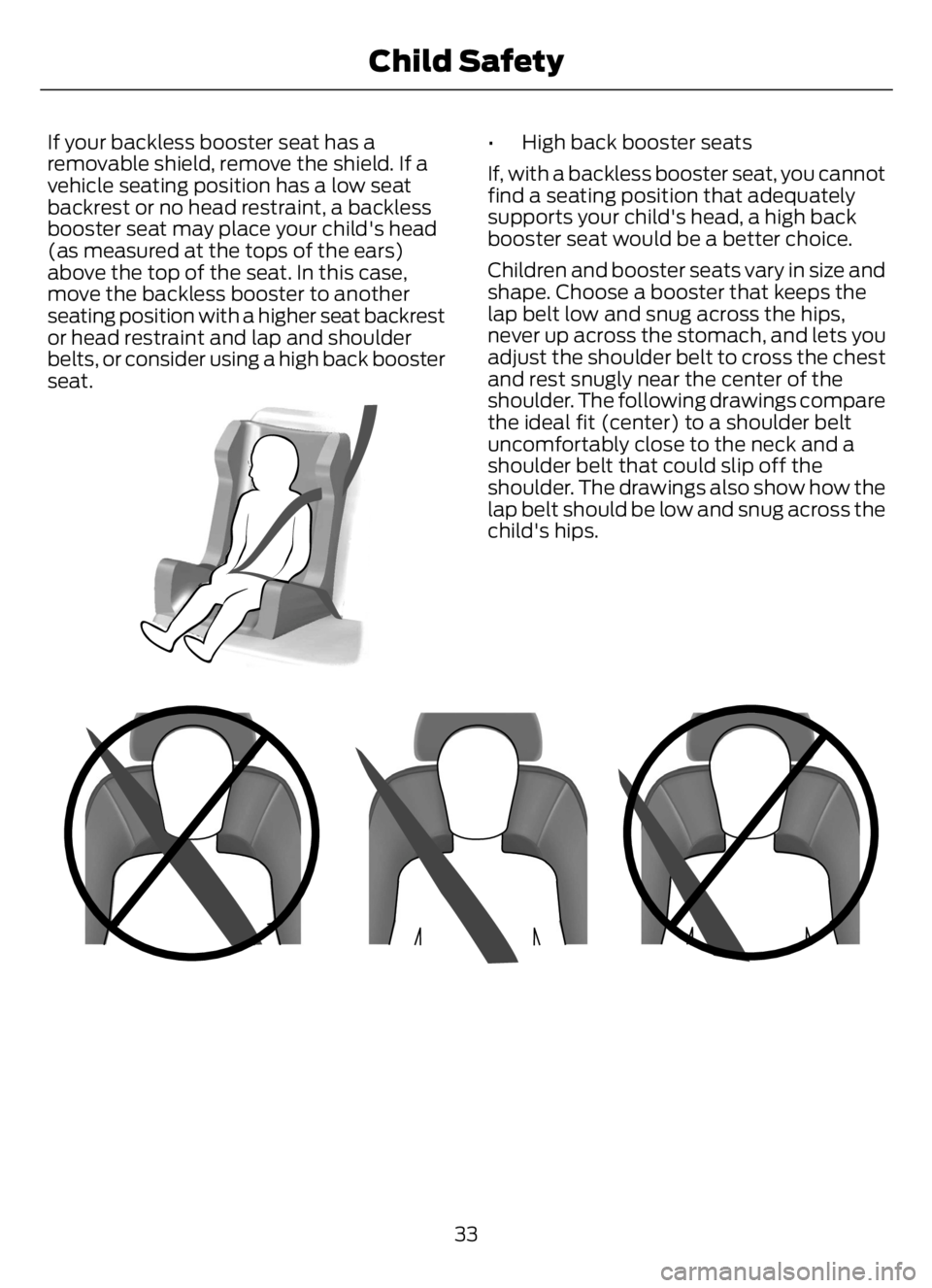
If your backless booster seat has a
removable shield, remove the shield. If a
vehicle seating position has a low seat
backrest or no head restraint, a backless
booster seat may place your child's head
(as measured at the tops of the ears)
above the top of the seat. In this case,
move the backless booster to another
seating position with a higher seat backrest
or head restraint and lap and shoulder
belts, or consider using a high back booster
seat.
E70710
• High back booster seats
If, with a backless booster seat, you cannot
find a seating position that adequately
supports your child's head, a high back
booster seat would be a better choice.
Children and booster seats vary in size and
shape. Choose a booster that keeps the
lap belt low and snug across the hips,
never up across the stomach, and lets you
adjust the shoulder belt to cross the chest
and rest snugly near the center of the
shoulder. The following drawings compare
the ideal fit (center) to a shoulder belt
uncomfortably close to the neck and a
shoulder belt that could slip off the
shoulder. The drawings also show how the
lap belt should be low and snug across the
child's hips.
33
Child Safety
Page 38 of 378

E14259742597
If the booster seat slides on the vehicle
seat upon which it is being used, placing a
rubberized mesh sold as shelf or carpet
liner under the booster seat may improve
this condition. Do not introduce any item
thicker than this under the booster seat.
Check with the booster seat
manufacturer's instructions.
CHILD RESTRAINT
POSITIONING
WARNING: Airbags can kill or injure
a child in a child seat. Never place a
rear-facing child seat in front of an active
airbag. If you must use a forward-facing
child seat in the front seat, move the
vehicle seat upon which the child seat is
installed all the way back. When
possible, all children age 12 and under
should be properly restrained in a rear
seating position. If all children cannot be
seated and restrained properly in a rear
seating position, properly restrain the
largest child in the front seat.
WARNING: Always carefully follow
the instructions and warnings provided
by the manufacturer of any child
restraint to determine if the restraint
device is appropriate for your child's size,
height, weight, or age. Follow the child
restraint manufacturer's instructions and
warnings provided for installation and
use in conjunction with the instructions
and warnings provided by your vehicle
manufacturer. A safety seat that is
improperly installed or utilized, is
inappropriate for your child's height, age,
or weight or does not properly fit the
child may increase the risk of serious
injury or death.
WARNING: Never let a passenger
hold a child on his or her lap while your
vehicle is moving. The passenger cannot
protect the child from injury in a crash,
which may result in serious injury or
death.
WARNING: Never use pillows,
books, or towels to boost a child. They
can slide around and increase the
likelihood of injury or death in a crash.
34
Child Safety
Page 39 of 378
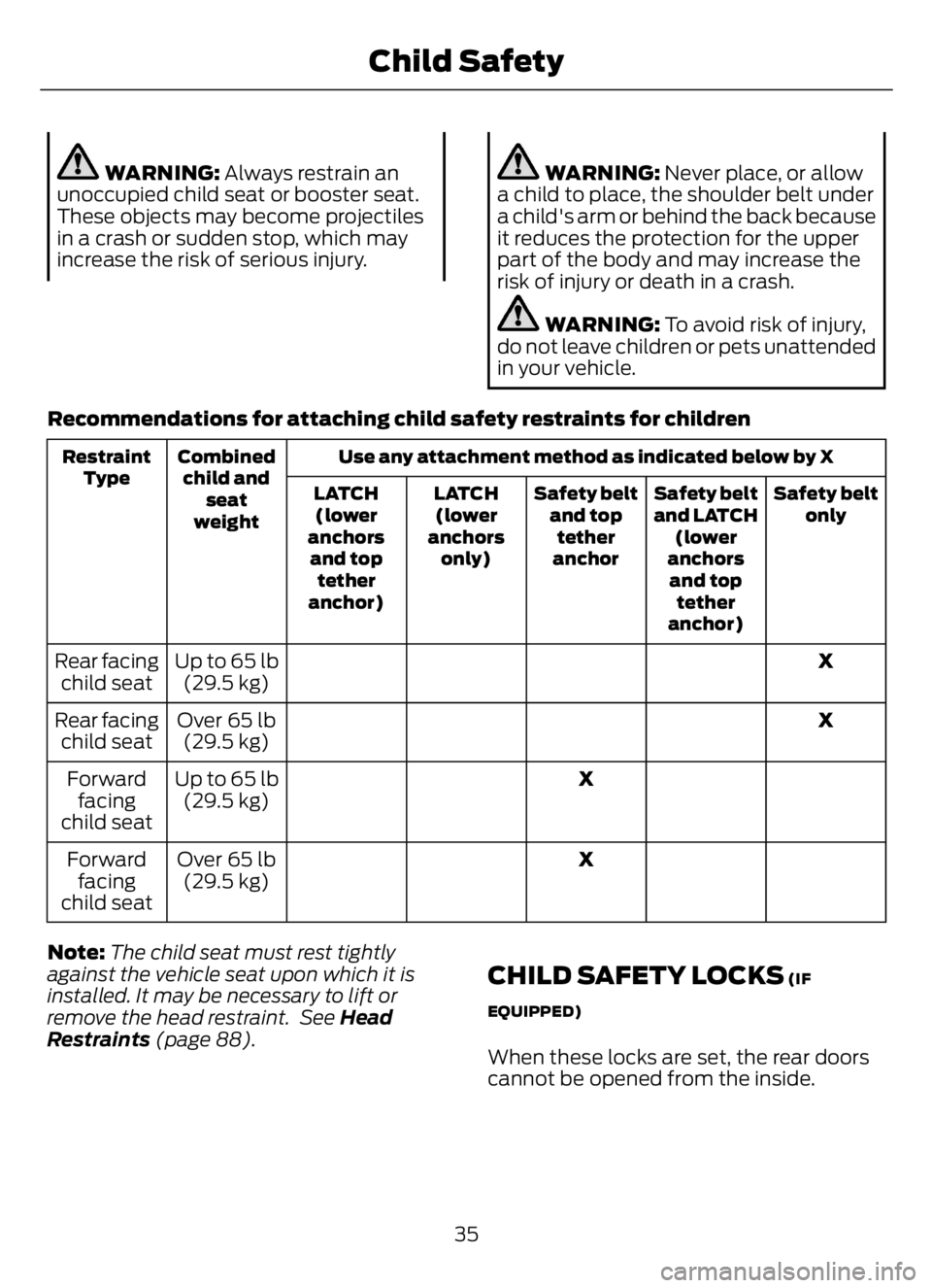
WARNING: Always restrain an
unoccupied child seat or booster seat.
These objects may become projectiles
in a crash or sudden stop, which may
increase the risk of serious injury.WARNING: Never place, or allow
a child to place, the shoulder belt under
a child's arm or behind the back because
it reduces the protection for the upper
part of the body and may increase the
risk of injury or death in a crash.
WARNING: To avoid risk of injury,
do not leave children or pets unattended
in your vehicle.
Recommendations for attaching child safety restraints for children
Use any attachment method as indicated below by X Combined
child and
seat
weight Restraint
Type
Safety belt
only Safety belt
and LATCH
(lower
anchors
and top
tether
anchor) Safety belt
and top
tether
anchor LATCH
(lower
anchors
only) LATCH
(lower
anchors
and top
tether
anchor)
X Up to 65 lb
(29.5 kg) Rear facing
child seat
X Over 65 lb
(29.5 kg) Rear facing
child seat
X Up to 65 lb
(29.5 kg) Forward
facing
child seat
X Over 65 lb
(29.5 kg) Forward
facing
child seat
Note:The child seat must rest tightly
against the vehicle seat upon which it is
installed. It may be necessary to lift or
remove the head restraint. See Head
Restraints (page 88).
CHILD SAFETY LOCKS (IF
EQUIPPED)
When these locks are set, the rear doors
cannot be opened from the inside.
35
Child Safety
Page 40 of 378

E162719
The childproof locks are located on the
rear edge of each rear door. You must set
the lock separately for each door.
Move the lock control up or down to
engage or disengage the childproof lock.
36
Child Safety